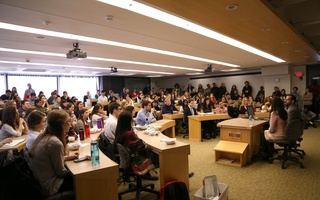Recently, a groundbreaking documentary about sexual assault on college campuses called “The Hunting Ground” was released to audiences nationally. Directed by noted documentary filmmaker Kirby Dick, the movie provides a direct look at the personal stories of those sexually assaulted at colleges and universities across the country. Sexual assault on college campuses is a crucial issue for a documentary to tackle and bring to the national consciousness, and what this movie aims to accomplish is critical for colleges nationally and for Harvard specifically.
Rigor, however, is key in any kind of journalism, and especially in a documentary that tackles such a sensitive issue. As a recent Crimson article pointed out, the “The Hunting Ground” misrepresented several statistics about sexual assault at Harvard. At one point, the documentary claims that, from 2009 to 2013, Harvard College experienced 135 sexual assaults on campus compared with only 10 expulsions. According to statistics released by the Administrative Board, however, 10 College students were required to withdraw, not expelled, during that four-year period due what the Ad Board classifies as “social behavior - sexual.” The Faculty of Arts and Sciences student handbook states that students who are forced to withdraw could potentially be readmitted, as opposed to students expelled by the Faculty Council. Of course, the fact that the number of expulsions due to sexual assault at the College is even lower than the filmmakers report only reiterates the severity of the problem they are addressing, but the film’s use of statistics is still inaccurate.
More problematic is the filmaker’s claim that 135 cases of sexual assault occurred at Harvard College between 2009 and 2013. While Dick’s statement to The Crimson that the figure came from statistics released by Harvard as required by the Clery Act is correct, his interpretation of that number is not. The number that the filmmakers cite actually covers the entire Cambridge campus, not just the College. The confusing way that Harvard releases these statistics makes this mistake understandable, if not excusable. Dick put it well when he told The Crimson that, “since Harvard College is not transparent about its number of sexual assaults or their adjudications, these are the available numbers that Harvard reports that convey the extreme gap between the number of assaults and number of severe sanctions.”
Still, misrepresenting facts in a piece of journalistic work is inexcusable. It is a violation of the journalistic code of ethics that not only misinforms the film's audience but also casts doubt on other publications and on journalism as a craft. This doubt is even more insidious in cases of sexual assault. Any inaccuracies serve as fodder for those who seek to deny the severity of the problem, and in doing so they detract from the cause at hand and devalue the individual stories of those affected by sexual assault.
Harvard shares some of the responsibility for not making more specific information about sexual assault available. The filmmakers, however, also had a responsibility to treat the data they had with more care, so that discussions of statistics did not delegitimize the broader and much-needed message of their documentary. As we move forward on this critical issue, we ask that the filmmakers issue a public correction of their statistical inaccuracies. The point of a correction is not to make the University look better—it is to meet the journalistic requirement of reporting facts truthfully and clearly. In the fight against campus sexual assault, honesty and forthrightness on all sides is essential.
Read more in Opinion
No Affordable Childcare for PostdocsRecommended Articles
-
 University Prepares To Launch Sexual Conduct Climate Survey
University Prepares To Launch Sexual Conduct Climate Survey -
Sexual Assault at HarvardThe success of this survey is in your hands. Please respond to the Westat invitation by taking the survey, regardless of whether you think the issue of sexual assault is directly relevant to you.
-
Bad Kopp: Harvard’s Sexual Assault SurveyWhen I look at the systemic problem of sexual assault on a macro level, I have a hard time seeing why I, or other men, should take up airspace talking about our experiences being assaulted by women when women are still so much more likely to be assaulted by men.
-
 Posters About Sexual Assault Crop Up in Sever
Posters About Sexual Assault Crop Up in Sever -
 In New York, Law School's Jeannie Suk Debates Title IX
In New York, Law School's Jeannie Suk Debates Title IX













